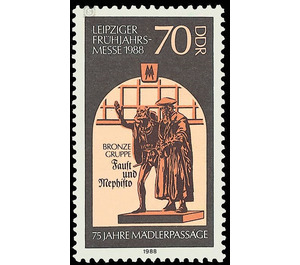Commemorative stamp series - Germany / German Democratic Republic 1988 - 70 Pfennig
Theme: Art & Culture
| Country | Germany / German Democratic Republic |
| Issue Date | 1988 |
| Face Value | 70.00 |
| Color | brown |
| Perforation | K 12 1/2: 13 |
| Printing Type | offset |
| Stamp Type | Postage stamp |
| Item Type | Stamp |
| Chronological Issue Number | 2896 |
| Chronological Chapter | GER-DDR |
| SID | 241956 |
| In 13 Wishlists | |
Leipzig Spring Fair 1988 On the occasion of the Leipzig Spring Fair in 1988, the Ministry of Posts and Telecommunications of the German Democratic Republic issued two multicolored special postage stamps. Special cancellation from March 8 to May 7, 1988 75 years Messehaus Mädler-Passage The most well-known Leipzig trade fair center is the "Mädler Passage" between Grimmaischer Straße and Neumarkt. Especially famous here is the historic restaurant "Auerbachs Keller", in which a scene from Goethe's "Faust" plays. The fair house "Mädler Passage" stands on historical ground. Here existed already in the 15th and 16th century a merchant's house, which was founded in 1519 by Dr. med. Heinrich Stromer was acquired. The doctor and university professor of medicine from Auerbach in the Bavarian Upper Palatinate was a progressive and cosmopolitan citizen of his city. He recognized the opportunity and began to build what was then a modern business building with more than 100 vaults that served as exhibition stands. The estate was completed in 1530, which became widely known as "Auerbachs Hof" and whose wine cellar was an attractive attraction. "Humanist Friedrich Tautmann wrote about 1600:" If you came to Leipzig to see the fair and did not come to Auerbachs Hof, the can not say that he was at Leipzig. "And he even called" Auerbach's Court "" Lipsia parva "(Leipzig in miniature)." This fame probably also led to Goethe's "Auerbachs Keller" in his play "Faust "Put a memorial. Because historically it is not proven that the famous magician Dr. Faustus, who was said to have performed at the Leipzig Mass in 1525, performed his jugglery here and enchanted students. However, Goethe's presence is documented: he often visited his friend Behrisch, who lives here, and even today, in the wine bar, a champagne receipt with the signature of the great poet can be seen. With the decline of the merchandise fair in the second half of the 19th century and the emergence of the model fair came the time of the fair palaces, and also the last hour of "Auerbachs Hof" had struck. The suitcase manufacturer Anton Mädler bought it in 1911 in order to have a modern fair house built here after complete demolition. Citizen protests forced the preservation of parts of the historic wine tavern. 75 years ago, the "Mädler-Passage" named exhibition house was first used for exhibition purposes; In 1914 it was completely finished. The fair house "Mädler Passage" was erected as reinforced concrete construction and covered with a facade of natural stone from the Elbe Sandstone Mountains. The four upper floors offer 8,000 square meters of exhibition space. In the two passages parts - L-shaped to each other and merged by a high rotunda - next to the historic wine restaurant other dining facilities, shops and service shops are housed. The high vaulted portals, the coat of arms above the gate, articulating columns and the vasegeschmückte gallery underline the architectural appeal of the designed and built in the style of the Baroque Italian galleries by the Leipzig Building Council Theodor Kösser building. The two world-famous life-size bronze groups of figures "Mephisto and Faust" and "The Merry Journeyman" at the entrances to "Auerbachs Keller" were created by the sculptor Matthieu Molitor. The "Mädler-Passage" exhibition center has always been home to glass and ceramics, as well as the "Auerbachs Hof." Leipzig's oldest fair exhibitor - the Meissen porcelain manufactory has been present at the Leipzig Trade Fair since 1710 - will be exhibiting here almost the entire time The special postage stamps show the portal of the fair house "Mädler-Passage" and the figure group "Mephisto and Faust", the first day cover one of the restaurant hangers on the Grimmaische Straße.


